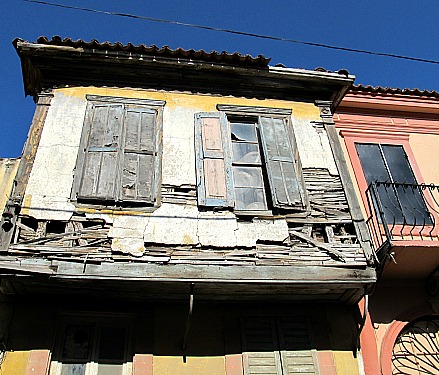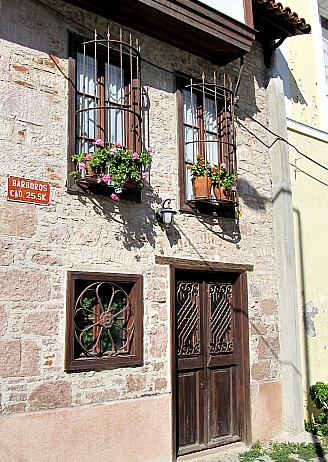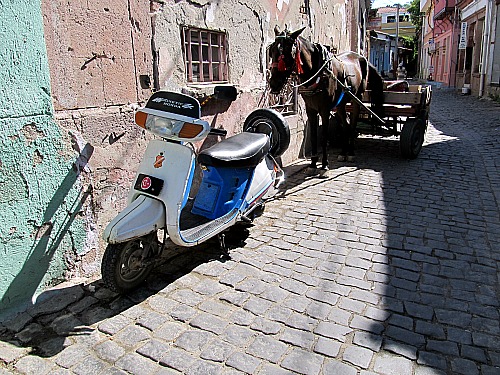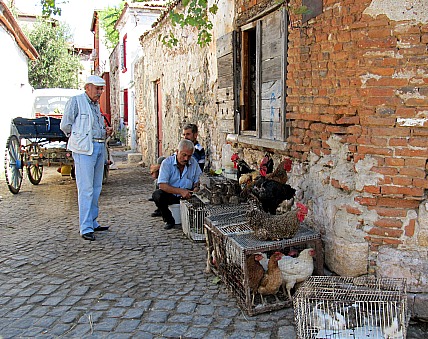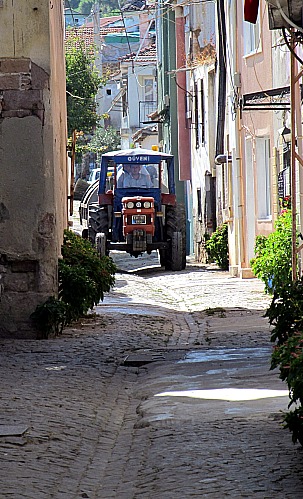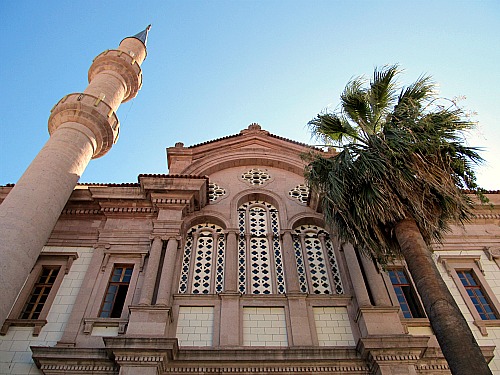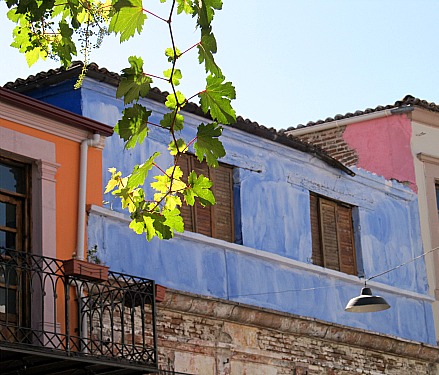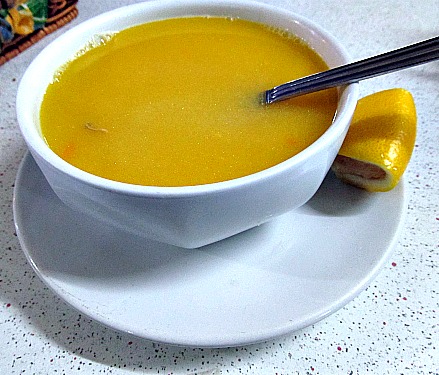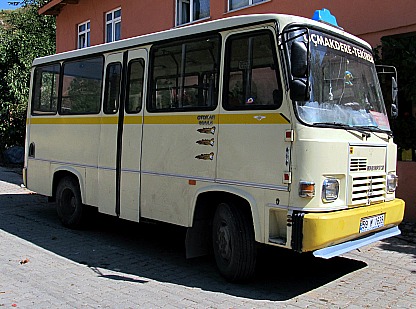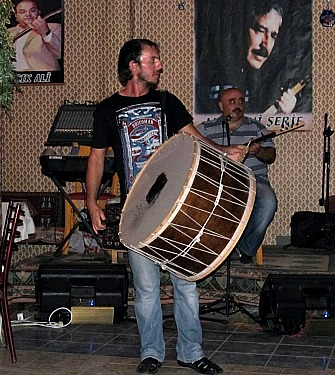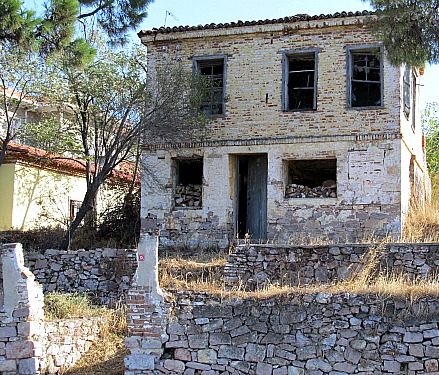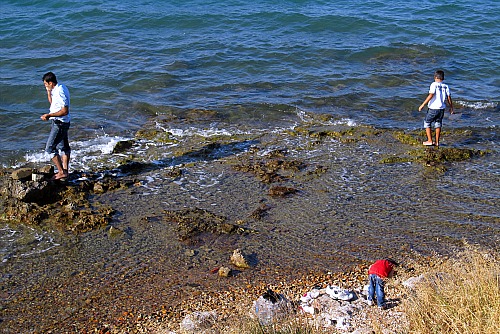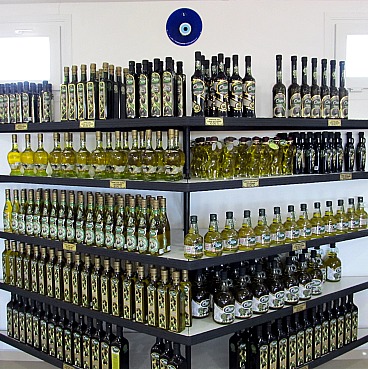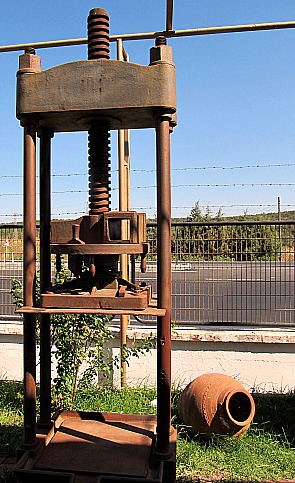There was plenty to look at and admire on our morning jaunt through the backstreets of Ayvalik.
Month: April 2012
Morning Walk In Ayvalik
As soon as our delicious breakfast — served on the glass-enclosed, sea-facing terrace — was over, Alp was taking us on a leisurely walking tour of the old back streets of Ayvalik.
This is something I really like to do: poke around the quiet back streets of villages, pausing at colorful and sometimes decrepit doors, admiring unique architectural details, or simply catching glimpses of people going about their daily lives.
I usually go by myself, often in the early morning. I wondered how it would be in a large group. It ended up being just fine.
The back streets of Ayvalik were deserted and quaint. Sometimes we’d cross paths with an old woman wearing a head scarf, carrying a bag on her way home from the market, or a young boy passing time on a tiny bike.
We passed a small mosque, the Alibey Mosque, made of pretty pink stone, and learned that it, as most of the town’s mosques, had been converted from an Orthodox church.
This fishing town is reminiscent of Greece, which isn’t surprising since a mostly Greek population lived here from the 1700’s to 1922. In that year, the town was taken over by Ataturk and subsequently, the entire Greek community was ousted in exchange for Muslims living in Greece.
Olive farming and olive oil production had been the main source of income for the Greeks. After the Turks took over the town, it became their main source as well, along with fishing, soap making, and tourism.
For decades the old Greek quarter of town has lain forgotten and neglected. Walking through this area with Alp, we passed several examples of 19th century Greek-style architecture: boxy stone houses in a variety of colors, most with crusty, decorative doors.
Starting a few years ago, these fine crumbling buildings are being bought up and refurbished. But even without repair, there is beauty in their decay.
We continued along, immersed in the images of backstreet Ayvalik.
In Search of Music at Garlic Beach
It was late afternoon when Jimmy drove us all to the city center. As soon as we stepped off the bus, we followed Alp’s directions and easily found the two stores where we hoped to find a battery charger. But no luck.
Then we stumbled upon Teknosa, a sort of Turkish Radio Shack. Better luck. They sold Sony video cameras just like ours! But we were crestfallen when they wouldn’t sell us just a charger. Although it had been fun using creative hand signs to explain what we needed, in the end we had to accept defeat. Back to no luck.
“You’ll find something in Izmir, our next overnight town,” Alp assured us.
There was nothing left to do at this point other than to use the remaining batteries judiciously and forget about it.
“It is what it is,” we said to each other and dove into the bazaar.
A small cafe inside the bazaar served fish soup. It was tasty and hot.
After perusing Ayvalik’s colorful food market, we met up with Chris at a dondura shop (remember that gloppy ice cream) along the quay. A group of people were gathered in the square nearby, drumming and waving Turkish flags in front of a large statue of Ataturk.
At first we thought they may have been protesting something, but when they started singing and bobbing around in a circle, it was apparent it was a celebratory gathering.
Chris and I were now on a mission to find traditional Turkish music. Alp had suggested we take a dolmus (pronounced “dol-moosh”) to Sarimsakli — “Garlic Beach” — about 15 minutes from town.
Dolmus are small buses, jitneys really, that operate like shared taxis, taking people from city to village or beach. They are easy, cheap, and convenient.
Chris, Gino, and I walked along the water a bit to where Alp had earlier pointed out a dolmus stop. One came by shortly and after determining it was going to Sarimsakli, we hopped on.
There were only locals on board. Following their lead, we paid by sending our money up front to the driver, hand over hand. The rule is that any change coming back to you returns the same way.
The little jitney followed the road that hugged the shore, passing our hotel and beyond. As we rode, we mentioned to some of the passengers that we were on a quest for music. When we arrived at the beach, one of them directed us to an area where we might find traditional music.
The area was very touristy: lots of people, lights, activity. Gino likened it to the Santa Cruz Boardwalk. In vain, we looked and listened for the strains of something besides electronic pop.
Finally, we found a place that seemed promising. At least the musicians were live: a drummer and two others. The drummer switched off between a doumbek and a large drum, but most of the time he just played a drum machine.
During their break, Chris went over and talked to them, even picking up the doumbek and letting loose a couple of riffs. A small group of young ladies came in and started line dancing. I thought of joining them, but they were in such sync I didn’t want to interrupt their rhythm.
After a drink, we realized it was getting late and we still needed to get ourselves back to the hotel. Instead of trying to find and wait for another dolmus, we decided just to split the cost of a taxi. Without any hassle, and spending little money, we were back at the hotel in no time.
It had been an interesting outing to Garlic Beach, but we still hadn’t found that true musical experience we were seeking.
The Outskirts of Ayvalik
The road in front of our hotel in Ayvalik was tight and busy; we had to grab our things from the bus and quickly get out of the way. The Cam Hotel would be our new home for the next couple of nights. It stands a few stories high, facing the sea directly across the road. From there it’s a pleasant and easy walk to the center of town.
Our room was spacious and comfy. A small balcony looked out onto the courtyard below, and off to the side, the sea. We settled in, washed out a few things and hung them on our balcony railing. Then, while most everyone else took a rest or regrouped, we took off on foot.
Ayvalik is a great little town and just the right size — small enough to be easily navigable, but big enough to be interesting. It was certainly not sleepy, which is just how we like them. Not sleepy, that is.
But as eager as we were to explore, our main objective right then was to find a battery charger for our video camera. Ours had quit and we were quickly running out of battery life.
Alp told us to look for the Turkish version of a Walmart: Migros or Tansas. (The Walmart reference turned out to be a rather exaggerated description, but I guess the qualifier was “Turkish version.”)
We walked along the waterfront, admiring the quaint homes lining the road.
Two young men riding a horse-drawn wagon filled with ripe watermelons tipped their hats at us as they plodded past.
We hadn’t yet come upon any Migros or Tansas, so we turned back before we reached the main part of town, knowing we would all be meeting up soon. Jimmy would be driving us right into the center to drop us off.
But it had been a pleasant walk after the hours on the bus.
But Where Are The Olives?
After leaving the hills of olive trees, we headed to a factory to see how the fruit becomes oil. Unfortunately, the warehouse was in between deliveries, so no olives were actually there being pressed. Nonetheless, we were given an extensive tour of the plant with a verbal explanation of the entire process.
My attention wandered. Since there was really nothing to see but a warehouse full of metal machinery, it was a bit boring. Frankly, I was more intrigued that some of the machinery had Italian words and brand names.
But after that, we stopped to visit a large shop that actually sold olives and oil. An assortment of the two were available for tasting, which we did.
Gino and I looked at all the bottles in various shapes and colors, but didn’t buy any. I don’t mean to sound snooty, but we live in California which produces the best oil in the U.S. This was nothing new for us.
We made one more tea stop along the road before rolling into our next home for the night: Ayvalik.








